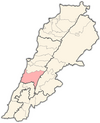Chouf District
Chouf District | |
|---|---|
District | |
| جبل الشوف | |
 Chouf Mountains | |
 Location in Lebanon | |
| Country | |
| Governorate | Mount Lebanon Governorate |
| Capital | Beiteddine |
| Area | |
| • Land | 191 sq mi (495 km2) |
| Time zone | UTC+2 (EET) |
| • Summer (DST) | UTC+3 (EEST) |
Chouf (also spelled Shouf, Shuf or Chuf, in Arabic جبل الشوف Jebel ash-Shouf) is a historic region of Lebanon, as well as an administrative district in the governorate (mohafazat) of Mount Lebanon.
Located south-east of Beirut, the region comprises a narrow coastal strip notable for the Christian town of Damour, and the valleys and mountains of the western slopes of Jabal Barouk, the name of the local Mount Lebanon massif. Chouf is the heartland of the Lebanese Druze community, with Druze leader Walid Jumblatt residing at the Jumblatt palace in the town of Moukhtara. The Emirs of Lebanon used to have their residence in Chouf, most notably Bachir Chehab II, who built the magnificent palace of Beiteddine during the first half of the 19th century. Another historical town, just facing Beiteddine, is Deir al Qamar (the monastery of the Moon).
Baakline, a historic and one of the largest towns in the Chouf, used to be the capital of old Mountain of Lebanon, where Druze Amir Fakhreddine II was born. He was well liked by both Christians and Druze and is probably the best leader who has ever ruled Lebanon. He switched his residence to Deir al Qamar due of a water shortage in Baakline. Deir al Qamar became then the capital of the Mount Lebanon Emirate.
The Chouf is living proof of the harmony between Maronite Christians and Druze, although several violent clashes have occurred between the two groups in 1848, 1860 and most recently in 1983-1984, during the Lebanese Civil War (Mountain War, Arabic: Harb el-Jabal). This saw the Progressive Socialist Party (PSP), a traditionally Druze oriented party, beat the Lebanese Forces (LF), comprising Maronite Christians. Reconciliation between the Druze and Christian communities came to fruition on August 8, 2001, when the Maronite Patriarch of Antioch, Cardinal Mar Nasrallah Boutros Sfeir made a historic visit to the Chouf and met with the Druze and Chouf leader, Walid Jumblatt.
Despite a bloody history, the Chouf is one of the best-preserved Lebanese districts and its nature has been generally spared from the intense building frenzy that has spoiled neighbouring Metn and Kesrouan. The biggest forest of Cedars of Lebanon is found on the flanks of Jabal Barouk.
Demographics
Despite the historical feuds between Christian Maronites and Druze, the Chouf district is still one of the most religiously diverse regions in Lebanon. The Druze are currently the largest religious denominations in the region with substantial Maronite and Greek Catholic populations. Roughly 65% of the region's inhabitants are Druze and 35% are of the Christian sect.
Cities and towns

- Ainbal
- Ain Qani
- Ammatour
- Anout
- Baadarâne
- Baakline
- Barja
- Barouk
- Batloun
- Beqaata
- Beitedine
- Beykoun
- Bsaba
- Bourjain
- Boutmeh
- Brih
- Chhime
- Dahr El Maghara
- Dalhoun
- Damour
- Daraya
- Deir el Qamar
- Deir Koucheh
- Dibbiyeh (Fairuz village)
- Gharife
- Haret Jandal
- Hasrout
- Fouara
- Jahlieh
- Jba'a[dubious – discuss] (This links to a town in the Nabatieh Governorate)
- Jdaideh
- Jiyyeh
- Joun (Nasri Shamseddine's village)
- Kahlouniye
- Kfarfakoud
- Kfarhim
- Mazboud
- Mazraat el chouf
- Maasser Beiteddine
- Moukhtara
- Mristi
- Mtolleh
- Niha Chouf (Wadih El Safi's village)
- Serjbel
- Shheem
- Zaarourieh
- Wadi el sett
- Warhaniyeh

